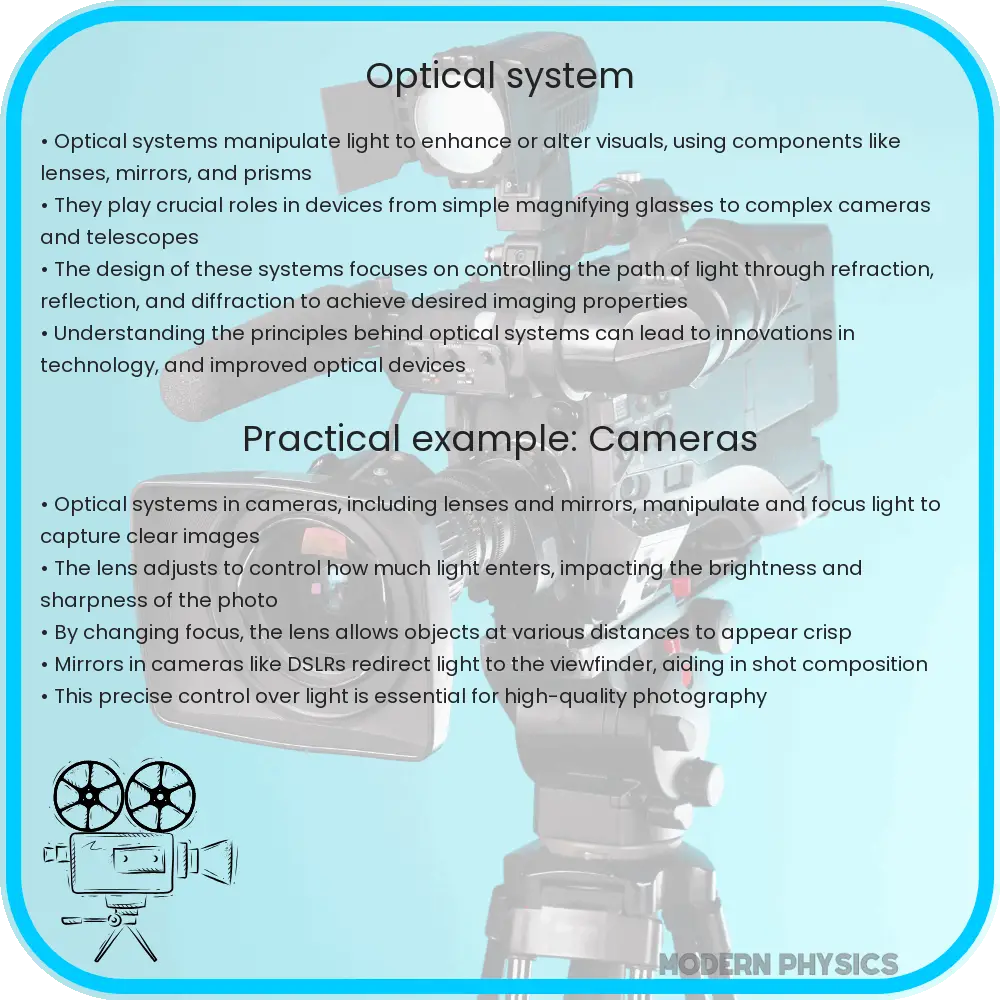Explore the essentials of optical system design, covering precision, geometric optics, aberrations, and advanced computational tools for innovation.

Understanding the Fundamentals of Optical Systems
Optical systems are pivotal in numerous fields, ranging from simple magnifying glasses to complex telescopes and microscopes. Their design and precision are grounded in intricate geometric and physical principles that determine how light interacts with various optical components. This article delves into the core concepts of optical system design, emphasizing the importance of precision and geometric fundamentals.
Precision in Optical Systems
Precision is the cornerstone of any optical system. It refers to the accuracy and consistency with which optical elements, like lenses and mirrors, are manufactured and aligned. This precision dictates the system’s capability to produce clear, undistorted images. For instance, in telescopes, the curvature of the mirrors must be shaped to exact specifications. Any deviation, even at the nanometer level, can lead to significant image aberrations.
Geometric Optics: The Basis of Design
Geometric optics is a branch of optics that uses rays to model the propagation of light. This concept is essential in designing optical systems as it helps in understanding how light is refracted or reflected by different surfaces. Snell’s Law, which describes the relationship between the angles of incidence and refraction, is a fundamental principle used in lens design.
- Refraction in Lenses: Lenses utilize the principle of refraction, bending light rays to focus them at a point. The degree of bending depends on the lens’s shape and the material’s refractive index, usually denoted as n. For instance, a converging lens (like a convex lens) brings parallel rays to a focal point, forming an image.
- Reflection in Mirrors: Mirrors work on the principle of reflection. The angle at which light hits the mirror’s surface (angle of incidence) equals the angle at which it reflects off (angle of reflection). This principle is crucial in designing reflective telescopes and other optical instruments.
Application of Ray Tracing
Ray tracing is a method used to predict the path of light rays through an optical system. By simulating how rays interact with optical surfaces, designers can optimize the system for minimal aberrations and maximum clarity. This process is especially important in complex systems, such as cameras and binoculars, where multiple lenses interact.
In conclusion, the precision and design of optical systems are deeply rooted in geometric concepts and principles of light behavior. Understanding these principles is essential for developing effective and efficient optical devices.
Advanced Concepts in Optical System Design
Delving deeper into the realm of optical systems, advanced concepts like wave optics and aberrations play a significant role. Wave optics, unlike geometric optics, considers the wave nature of light, allowing for the analysis of phenomena like diffraction and interference. This aspect is crucial in the design of systems where light’s wavelength-scale effects are significant, such as in diffraction gratings and holography.
Addressing Aberrations in Optical Systems
Aberrations are deviations from ideal image formation, often caused by imperfections in optical elements or design flaws. They manifest as blurs, halos, or color fringing in images. Modern optical design strives to minimize aberrations through precise engineering and the use of sophisticated materials. Chromatic aberration, for instance, is addressed by using achromatic lenses, which combine different glass types to focus various wavelengths at the same point.
Material and Coating Technologies in Optics
The choice of materials and coatings in optical systems is another crucial factor. Optical glasses and crystals with specific refractive indices and dispersion properties are selected based on the application. Additionally, anti-reflective coatings are applied to reduce light loss due to reflection, thereby enhancing transmission and image brightness.
Computational Optics: The Future of Optical Design
The integration of computational tools in optical design has revolutionized the field. These tools enable the simulation and optimization of complex optical systems, foreseeing performance before physical prototypes are made. Computational optics not only speeds up the design process but also opens up possibilities for innovative designs that were once thought impossible.
Conclusion
Optical systems are a blend of art and science, where precision and innovative design meet fundamental physical laws. From the basic principles of geometric optics to the complex considerations of wave optics and aberrations, the design of optical systems is a meticulous process that demands both technical expertise and creative problem-solving. The ongoing advancements in materials, coatings, and computational optics continue to push the boundaries, allowing for more sophisticated and efficient optical devices. Whether it’s in enhancing our vision, exploring the cosmos, or advancing scientific research, optical systems continue to play a pivotal role in expanding our understanding of the world around us.
